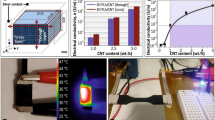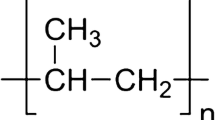Abstract
This paper deals with results of the thermodielectric effect measurement. A paraffin wax as a dielectric material was investigated via differential scanning calorimetry and potentiometry during a phase transition. Possible description of the thermodielectric effect based on fundamental laws of thermodynamics is shown; to be more specific, the link between the potential difference and the latent heat is presented. The thermodynamic model of thermodielectric effect based on electrochemical equilibrium and charge generation at the solid/liquid interface is introduced. Results of the thermodielectric effect measurement are used for the calculation of a molecular mass of the paraffin wax. The relation for a surface area (interface) between liquid and solid phase of the paraffin wax during solidification is derived from the presented theoretical description of the thermodielectric effect.




Similar content being viewed by others
References
J. Costa Ribeiro, An. Acad. Brasil. Cienc. 3 (1950)
B. Gross, Phys. Rev. 94, 1545–1551 (1954)
A. Dias Tavares, J. Mol. Liq. 39, 171–194 (1988)
V.L. Bronshteyn, A.A. Chernov, J. Cryst. Growth. 112, 129–145 (1991)
L. Onsager, P.C. Hemmer, H. Holden, Collected work of Lars Onsager: with commentary (World Scientific, Singapore, 1996)
E.J. Workman, S.E. Reynolds, Phys. Rev. 78, 254–259 (1950)
A.R. Hippel, Dielectric materials and applications (Artech House, London, 1995)
P. Eyerer, Adv. Colloid Interface Sci. 3, 223–273 (1972)
V. LeFebre. J, Colloid Interface Sci. 25, 263–269 (1967)
S.R. de Groot, P. Mazur, (North-Holland, Amsterdam, 1962)
M. Pavelka, F. Marsik, J. Int. Hydrogen Energ. 38, 7102–7113 (2013)
P. Atkins, J. de Paula, Physical Chemistry, eight ed. (Oxford University Press, Oxford, 2006)
F. Marsik, J, Non-Equil. Thermody. 19, 197–216 (1994)
H.B. Callen, Thermodynamics and an introduction to thermostatistics (John Wiley & Sons, Singapore, 1985)
D. Pinatti, S. Mascarenhas, J. Appl. Phys. 38, 2648–2652 (1967)
M. Freund, R. Csikos, S. Keszthelyi, G.Y. Mozes, Paraffin products: properties, technologies, applications (Elsevier, Budapest, 1982)
Z. Liu, D.D.L. Chung, Thermochim. Acta. 366, 135–147 (2001)
S. Himran, A. Suwono, G.A. Mansori, Energ. Source. 16, 117–128 (1994)
Z. Zhang, X. Fang, Energ. Convers. Manage. 47, 303–310 (2006)
R.G. Craig, J.M. Powers, F.A. Peyton, J. Dent. Res. 46, 1090–1097 (1967)
Acknowledgments
The result was developed within the CENTEM project, reg. no. CZ.1.05/2.1.00/03.0088, co-funded by the ERDF as part of the Ministry of Education, Youth and Sports OP RDI programme. We are sincerely grateful to reviewer of Brazilian Journal of Physics for the useful comments.
Author information
Authors and Affiliations
Corresponding author
Appendix: Basic assumption of the materialand the electromagnetic interaction - Maxwell equations
Appendix: Basic assumption of the materialand the electromagnetic interaction - Maxwell equations
The basic quantities needed for the description of the polarizable and magnetizable materials are the electric field intensity E [V⋅m−1=N⋅C−1] and magnetic field density (magnetic induction) B [T=Wb⋅m−2=kg ⋅s−2⋅A−2]. Both of these quantities do not depend on the material properties (are the same in the free space) and they can be taken as the qualitative quantities, similarly as the temperature in an equilibrium system. To evaluate the polarization and magnetization, we need to formulate Maxwell’s equations (37, 38, 39) by means of the polarization P and the magnetization M vectors [10],
The righthand sides of Eqs. (37, 38) depend on the material composition, expressed by the mass fraction w α =M α c α /ρ, where M α is molecular mass, c α is molar concentration [ mol ⋅m−3] and \(\rho =\sum \limits _{\alpha } \rho _{\alpha }\) is density of the mixture, in our case for α=s,l (s - solid part, l - liquid part of the mixture) [10, 11]. The electric induction and the magnetic field intensity connected with the component α are defined as follows:
It is possible to write divD=ρ e , where ρ e is the density of free electric charge, so that div(ε 0 E)=ρ e +ρ b is the density of total charge. Provided that the polarization and magnetization are equal to zero for the vacuum, follow from the (37, 38) very important relations for the bounded charge and corresponding bounded electric flux, which is especially relevant for unsteady processes
In many practical applications, especially for homogeneous and isotropic materials, the simplified relations are used
Then, the effects of electric and magnetic fields on the material body are represented by the electric susceptibility χ e and by the magnetic susceptibility χ m. Alternatively, this interaction can be formulated by the relative permittivity ε r and relative permeability μ r as follows
so that
These equations are important for the formulation of the momentum and energy balance equations in the presence of electromagnetic phenomena.
Rights and permissions
About this article
Cite this article
Tomas, M., Novotny, P. The Thermodielectric Effect in Paraffin Wax. Braz J Phys 45, 28–35 (2015). https://doi.org/10.1007/s13538-014-0282-y
Received:
Published:
Issue Date:
DOI: https://doi.org/10.1007/s13538-014-0282-y




